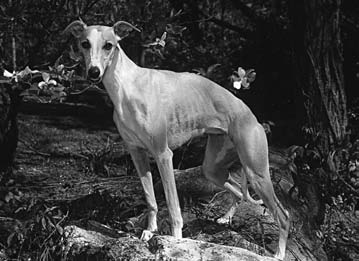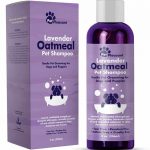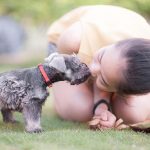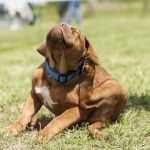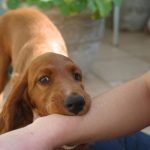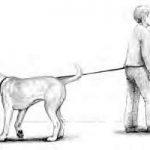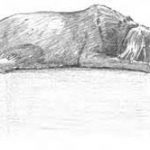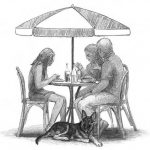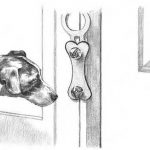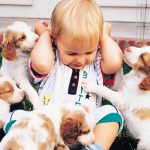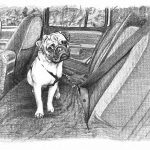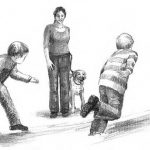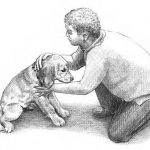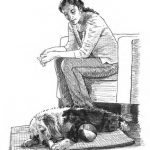- Characterizing the Hounds
- Learning to live with a super sniffer
- Setting your sights on Sighthounds
- Pursuing the best breed for your lifestyle
Dogs are known for their keen eyesight and acute sense of smell. After all, who hasn’t seen a pup take off after a leaf skittering down a path? And what about those wet noses poked out of car windows? Dogs love to set their sniffers on a scent. But Hounds, by far, boast the best of these senses.
Most Hounds are bred to be hunters — to spot quarry or follow a trail and then have the stamina to keep going for as long as it takes. Part of the Hound group’s appeal is that the breed is independent, with instincts so strong that commands often aren’t necessary. These dogs understand their job and are happy and focused on doing it.
For owners, the problem lies in the fact that a Hound may not be inclined to obey a command when one is given, especially if there’s an enticing scent on the breeze or a squirrel making a mad dash across the yard. Worse yet is the unleashed Hound who sets its sights on the squirrel and takes off without regard to safety.
Though all Hounds live to pursue prey, the group is a diverse lot. From the showy Afghan to the stocky Basset, the Hounds come in all shapes, sizes, colors, and coat types. Consider the Pharaoh Hound: Its stately form, going back to ancient times, is built like a Greyhound for speed, but with large, upright ears that can home in on animals underground. The Otterhound is a sturdier dog built for hunting in and around cold water, equipped with large, webbed feet for slippery terrain and a rough coat with an oily undercoat that protects it from brambles and chilly English streams.
Hound temperaments vary as widely as looks. Although all are wired to hunt, most are happy to hit the couch or curl up at your feet at the end of the day. The desert Hounds such as the Saluki and Pharaoh tend to be aloof and less demonstrative. Feisty dogs in small packages, the Dachshund and Basenjis, are confident, bold, and often described as Terrier-like. Friendly are the Beagles, and Coonhounds are known for their sweet and mellow natures.
Hunters are an obvious choice for Hound ownership, but plenty of athletic people — runners, hikers, and other sporty types — can give a Hound the outlet he needs for sniffing and chasing. This chase instinct is strong, so all Hounds need leashed outings and secure fencing.
Some Hounds, Foxhounds and Beagles among them, produce a unique sound called baying — that chattering howl you may have heard in movies when Hounds are hunting. Be sure you can live with this sound before bringing one of these Hounds into your life.
The Hound Group is divided into two subgroups:
– Sighthounds: Also called Gazehounds, these Hounds are some of the fastest breeds around, bred to spot and chase prey. The Sighthounds, which tend to be sleeker than their Scenthound cousins, include the Afghan, Basenji, Borzoi, Greyhound, Ibizan, Irish Wolfhound, Pharaoh, Saluki, Scottish Deerhound, and Whippet. Today’s Sighthounds are rarely used for hunting; most, however, excel at lure coursing, running with their human partners, or competing on racetracks. The typical Sighthound is quiet, aloof, and calm.
– Scenthounds: Whether they’re tracking scent in the air or on the ground, Scenthounds are driven by the need to sniff down prey. These dogs typically are solidly built and include the Basset, Beagle, Black and Tan Coonhound, Bloodhound, Dachshund, American and English Foxhounds, Harrier, Norwegian Elkhounds (though of the Spitz family), Otterhound, Petit Basset Griffon Vendeen, Plott, and Redbone Coonhound. This group tends to be social; dogs often work in packs and live and play together. The group’s sociable nature has helped earn the Scenthounds a reputation for being amiable and adaptable companions.
With both talented nose and eyes, the Rhodesian Ridgeback fits into the Sighthound and Scenthound groups.
Afghan Hound
History/Evolution: Although some link its origins to ancient Egypt, the Afghan Hound was developed in Afghanistan; in the early 1900s, it was brought to England. Primarily a coursing Hound, the Afghan was a fast, agile, and accomplished hunter that at times was paired with specially trained falcons. The breed’s dignified appearance and silky coat helped bring it into the spotlight in the show ring. Although the glamorous Afghan was fashionable in the 1970s, the breed’s popularity has since dwindled.
Size: Large; females 25 inches, 50 pounds; males 27 inches, 60 pounds.
Color: Any.
Temperament: Aloof and dignified, but with a clownish side. Independent hunter. Not overly demonstrative with family, reserved with strangers.
Energy level: Medium, higher when young.
Best owner: Active owner in a suburban or rural home.
Needs: Daily exercise (long walks, sprints, and runs), fenced yard, leash, regular and consistent coat care.
Life expectancy: 12 years.
American Foxhound
History/Evolution: A native U.S. breed, the American Foxhound traces its origins to the late 1600s and early 1700s, when it was developed from various Hound breeds imported from France, England, and Ireland. George Washington, who ran a breeding program for the breed, is sometimes called the father of the American Foxhound. Although the breed’s great speed and agility have made it a popular choice for hunters, the American Foxhound has experienced limited popularity as a pet for nonhunters.
Size: Large, 40 to 65 pounds; females 21 to 24 inches; males 22 to 25 inches.
Color: Any.
Temperament: Tolerant, gentle, amiable; reserved with strangers, but can be a well-mannered household companion. A hunter at heart; may be stubborn or independent.
Energy level: High.
Best owner: Active owner in suburban or rural area.
Needs: Daily exercise (long walks or runs), fenced yard, minimal brushing to remove dead hair, tolerance of baying, companionship, a patient trainer.
Life expectancy: 11 to 13 years.
Photograph © Isabelle Francaise
Basenji
History/Evolution: The lightly built Basenji was used for hunting game in its native Central Africa and was prized for its speed and intelligence and for its very specialized trait: Known as the “Barkless Dog,” the Basenji is a silent hunter. However, the Basenji emit joyful yodels during play and when greeting family. Despite some unsuccessful attempts to bring the breed to England in the late 1800s, the Basenji eventually was established outside of Africa in England and, in 1941, the U.S.
Size: Small; females 16 inches, 22 pounds; males 17 inches, 24 pounds.
Color: Chestnut red, black, black and tan, or brindle with white markings.
Temperament: Feisty, intelligent, curious, and independent; affectionate with friends and family, but reserved with strangers. Fastidious about grooming.
Energy level: Medium to high.
Best owner: Active owner with fenced yard and time for canine exercise.
Needs: Daily mental and physical exercise (walks, games, free runs), fenced yard, minimal coat care.
Life expectancy: 12 to 14 years.
Photograph © Jean Fogle
Basset Hound
History/Evolution: Developed in France as a low-legged trailer of small game, the Bassett Hound was highly popular during the reign of Napoleon. The Marquis de Lafayette brought them to the U.S. as a gift to President George Washington to use in his hunting expeditions. In 1884, the first Basset Hound was exhibited at the Westminster Kennel Club show. Beloved companion of many, the Basset Hound continues to prove itself in conformation, obedience, tracking, hunting, and field trials.
Size: Medium, but heavy boned; 14 inches, 40 to 60 pounds.
Color: Hound colors: black, tan, and white markings; red with white; piebald.
Temperament: Sweet, gentle, good natured; easygoing with children, other dogs, and pets. Can be stubborn and slow moving when on the trail of a scent.
Energy level: Low, but can have great stamina when hunting.
Best owner: Patient trainer who lives in a home with a backyard.
Needs: Daily leashed walk; great tolerance of drool and dirt distributed by big feet and trailing ears; minimal grooming, but regular ear cleaning to avoid infections and odor.
Life expectancy: 10 years.
Beagle
History/Evolution: Though details of the Beagle’s origins are somewhat uncertain, Beagle-type dogs were used to hunt rabbits in England as early as the 14th century. The sturdy breed has undergone changes, but today’s Beagle comes in two height varieties. Beagles are still used for hunting in packs, but they are equally valued for their merry personality and loyal companionship. Their intelligence, compact size, and care-free coat have made them one of the most popular breeds in the U.S.
Size: Small; 13 to 15 inches, 16 to 30 pounds.
Color: Hound colors: usually black and tan, red, or lemon, with or without white markings.
Temperament: Amiable, tolerant, good with children, curious, and mischievous if not provided with enough exercise. Independent thinker when he detects a scent.
Energy level: Medium.
Best owner: Active owner with securely fenced backyard.
Needs: Daily exercise and playtime, leash, adequate fencing to prevent digging, companionship, minimal grooming, tolerance of barking, howling, and begging.
Life expectancy: 12 to 15 years.
Photograph © Jean Fogle
Black and Tan Coonhound
History/Evolution: An all-American breed, the Black and Tan Coonhound was developed from other Scenthounds used to hunt raccoons and bears in rugged terrain. Following in the footsteps of their Bloodhound ancestors, the Black and Tan trails with nose to the ground and is a determined hunter even in the worst conditions. The dog’s deep voice enables a hunter to find him after he’s treed his quarry. Registered with the AKC in 1945, the breed is favored more for hunting than as a show dog or pet.
Size: Large, 65 to 100 pounds; females 23 to 25 inches; males 25 to 27 inches.
Color: Coal black with tan markings.
Temperament: Mellow, even tempered, calm; friendly and playful, but reserved with strangers. Strong trailing instincts make training difficult.
Energy level: Moderate.
Best owner: Hunter or family with large, secured backyard.
Needs: Daily exercise, leash, consistent training, tolerance of loud baying and drooling, weekly ear cleaning to prevent odor and infection.
Life expectancy: 10 to 12 years.
Photograph © Isabelle Francaise
Bloodhound
History/Evolution: One of the oldest Scenthounds (some have traced the Bloodhound to Mediterranean countries in the third century), most believe that the breed was developed in Europe during the Middle Ages. The name refers to blooded hounds, meaning they were of pure blood and noble breeding. The Bloodhound’s trailing skills in the field of law enforcement have earned the breed high honors. This highly recognizable dog excels in shows and trailing but has enjoyed moderate popularity as a pet.
Size: Large, 80 to 110 pounds; females 23 to 25 inches; males 25 to 27 inches.
Color: Black and tan, liver and tan, and red.
Temperament: Trustworthy, extremely affectionate, calm; tolerant of children and playful. Reserved with strangers. Ruled by its nose.
Energy level: Lots of energy until 3 or 4 years of age; then low.
Best owner: Active owner with a firm approach to training.
Needs: Daily exercise, securely fenced yard, leash, drool tolerance, facial cleaning (ears and wrinkles pick up food and water), soft bedding, weekly brushing.
Life expectancy: 7 to 10 years.
Photograph © Jean Fogle
Borzoi
History/Evolution: A graceful, elegant Sighthound, the Borzoi was developed by the Russian aristocracy. Known as the Russian Wolfhound before 1936, the Borzoi was originally bred to hunt wolves, often in packs of more than a hundred dogs. The first Borzoi was brought to the U.S. from England in 1889; today the breed is prized for its beauty and talent in the show ring, as well as its skill in lure coursing. Farmers in Western states still rely on the Borzoi to control coyote populations.
Size: Large; females 26 to 30 inches, 65 to 85 pounds; males 28 to 33 inches, 85 to 105 pounds.
Color: Any color, with or without markings.
Temperament: Intelligent, sensitive, and well mannered; described as catlike in their independent nature. Affectionate with family, but reserved with strangers. Strong chase instinct.
Energy level: Low.
Best owner: Runner or active owner with fenced yard.
Needs: Daily exercise (leashed walk plus a sprint in a well-secured area), patient and consistent obedience training, socialization, regular brushing and bathing, cool quarters.
Life expectancy: 10 to 12 years.
Photograph © Jean Fogle
Dachshund
History/Evolution: Developed hundreds of years ago in Germany, the Dachshund was bred to be a fearless, long-bodied dog who could dig a badger out of its burrow and kill it (the breed’s name means “badger dog” in German). The Dachshund has a sharp sense of smell and is an eager hunter, both above and below ground. One of the most popular AKC breeds, the friendly Dachshund comes in three different coat varieties (smooth, wirehaired, and longhaired) and can be miniature or standard size.
Size: Small; miniature less than 11 pounds; standard usually between 16 and 32 pounds.
Color: Sable, chocolate, black and tan, or chocolate and tan, all with or without brindling or merling.
Temperament: Bold, curious, and courageous; toddlerlike and comical. Independent, but playful and family oriented; longhairs a good choice for families with children.
Energy level: Medium to high.
Best owner: Confident owner with time for training.
Needs: Daily exercise, regular grooming (varies with coat type), obedience training, precautions against back injuries, mindfulness about overeating.
Life expectancy: 12 to 14 years.
Photograph © Jean Fogle
English Foxhound
History/Evolution: Breeding records for the English Foxhound date back to the late 1700s in Great Britain, where the breed was developed to have great stamina and trailing skills. By the late 1800s, foxhunting had become extremely popular with the wealthy, who built up great fanfare around the hunts. The English Foxhound was brought to the U.S. and bred with other dogs to create the American Foxhound. Many people still regard the English Foxhound as the first choice when pursuing a traditional hunt.
Size: Large, 24 to 26 inches; females 60 to 80 pounds; males 75 to 90 pounds.
Color: Hound colors: black, tan, and white.
Temperament: A pack Hound at heart; can be strong, stubborn, and independent. Amiable, gentle, tolerant. Reserved with strangers.
Energy level: High.
Best owner: Active, patient owner in a rural or suburban house.
Needs: Daily exercise (long leashed hikes) and activity to prevent boredom and destructive behaviors, fenced yard, consistent obedience training, companionship, occasional brushing.
Life expectancy: 10 to 13 years.
Photograph © Jean Fogle
Greyhound
History/Evolution: With origins going back to ancient Egypt, the Greyhound is one of the oldest breeds known. Important breed developments were made in Great Britain when the Greyhound was kept and bred by royalty. The Greyhound pursued game by using both vision and speed, and was used to hunt deer, fox, and hare. Spanish explorers brought the breed to the U.S. in the 1500s; the AKC recognized the Greyhound in 1885. Today the Greyhound is regarded as a sweet and lively companion.
Size: Large; females 60 to 65 pounds; males 65 to 70 pounds.
Color: Immaterial.
Temperament: Quiet, well mannered, and calm. Possesses independent Hound spirit, loves to chase. Can be timid and sensitive; reserved with strangers.
Energy level: Medium to high, lower in dogs older than age 3.
Best owner: Active owner in rural or suburban home.
Needs: Daily exercise (long leashed walks with sprints), fenced yard, patient training, soft bedding and warm surroundings, occasional brushing.
Life expectancy: 10 to 13 years.
Photograph © Jean Fogle
Harrier
History/Evolution: Developed in England during the Middle Ages, the Harrier was bred to hunt hare in packs. The sturdy, large-boned breed was tireless and tough but not particularly fast, making it a good companion for hunters on foot. Harriers have been used in the United States for hunting since Colonial times. Though not ranked particularly high by the AKC, the Harrier serves as a family companion and fine competitor in tracking and agility.
Size: Medium; 19 to 21 inches, 45 to 60 pounds; females slightly smaller than males.
Color: Any.
Temperament: Outgoing, intelligent, friendly; amiable, tolerant, good with children. Most reserved with strangers. Strong hunting instinct; easily bored.
Energy level: High.
Best owner: Hunter or active owner in a rural or suburban home.
Needs: Daily exercise and activity, leash, tall and secure fencing, canine companionship, occasional grooming.
Life expectancy: 10 to 12 years.
Photograph © Isabelle Francaise
Ibizan Hound
History/Evolution: The Ibizan Hound’s roots can be traced back to the days of ancient Egypt, when sea traders are believed to have brought Hounds to the island of Ibiza off the coast of Spain. A skilled runner and jumper, the Ibizan was used in packs to hunt rabbits in the rough terrain of its native land. The elegant Hound with amber eyes was brought to the U.S. in the mid-1950s. Though a rare breed, the Ibizan is a highly regarded competitor and makes an excellent family pet.
Size: Large; females 221⁄2 to 26 inches, 45 pounds; males 231⁄2 inches to 271⁄2 inches, 50 pounds.
Color: White or red, solid or in combination.
Temperament: Even tempered, affectionate, loyal; intelligent and trainable. Aloof with strangers; some can be timid. Good with children and other pets.
Energy level: Moderate to high.
Best owner: Active owner in a rural or suburban home.
Needs: Daily exercise (long walks with chances for sprints), tall fences, warm surroundings and soft bedding, occasional brushing (weekly for wire coat).
Life expectancy: 12 to 14 years.
Photograph © Jean Fogle
Irish Wolfhound
History/Evolution: An ancient breed, the Irish Wolfhound can be found in records dating back to AD 391, when royal gifts of the giant hunters were made to Rome. Irish Wolfhounds fought with their masters, guarded castles, and hunted wolves and elk, nearly to the point that the dogs’ own existence was at risk. Breeders restored the Irish Wolfhound in the 1800s. Potential owners must consider the amount of space and attention required to keep the Irish Wolfhound happy and healthy.
Size: Large; females 30-plus inches, 105 pounds; males 32-plus inches, 120 pounds.
Color: Gray, brindle, red, black, white, and fawn.
Temperament: Gentle, easygoing, patient, sweet. Good with children and pets; friendly with strangers. Can be stubborn and may be sensitive to harsh training methods.
Energy level: Low, unless in pursuit of game.
Best owner: Owner with a spacious home.
Needs: Daily exercise, fenced yard, ample room indoors, soft bedding, attention and companionship, weekly brushing and occasional scissoring.
Life expectancy: 5 to 7 years.
Photograph © Jean Fogle
Norwegian Elkhound
History/Evolution: Though the Norwegian Elkhound has its roots in the Spitz family, the breed’s tracking abilities have earned it a place of honor in the Hound Group. An ancient breed that hunted with the Vikings, the Norwegian Elkhound is hardy and has the stamina to outlast moose, bear, and hunter alike. The breed is devoted to the chase but also thrives on human companionship, making it a good candidate for an active family’s pet.
Size: Medium; females 19 1⁄2 inches, 48 pounds; males 201⁄2 inches, 55 pounds.
Color: Gray.
Temperament: Playful, bold, independent. Alert and ready for adventure, preferably in cold weather. May be destructive if not given enough exercise. Good with children and strangers, but not other dogs.
Energy level: High.
Best owner: Active owner with plenty of time for exercise.
Needs: Daily strenuous exercise, fenced yard, training, a social life, tolerance for shedding, patience with barking, cool weather, attention to overeating.
Life expectancy: 10 to 12 years.
Photograph © Isabelle Francaise
Otterhound
History/Evolution: Although the Otterhound was used to prevent otters from preying on fish in the rivers and streams of England, the breed’s origins are believed to be in France. Otter hunting has since been banned, but the Otterhound has found a place with some as an amiable companion. The breed’s webbed feet help facilitate its love of being in the water, whether it’s a river, pool, or puddle. The AKC recognized Otterhounds in 1909.
Size: Large; females 23 to 26 inches, 65 to 100 pounds; males 24 to 27 inches, 75 to 115 pounds.
Color: Any — usually black and tan, grizzle, red, liver and tan, tricolor, or wheaten.
Temperament: Boisterous, amiable, easygoing; good with children. May be stubborn and less than responsive to training, especially when outdoors and a scent is detected.
Energy level: Medium to high as a youngster.
Best owner: Hunter or some other outdoorsy type.
Needs: Daily exercise, leash, fenced yard, training, companionship (human and canine), tolerance of baying, acceptance of wet beard, weekly brushing and occasional bathing.
Life expectancy: 12 to 14 years.
Photograph © Isabelle Francaise
Petit Basset Griffon Vendéen
History/Evolution: The Petit Basset Griffon Vendeen, or PBGV, originated in the Vendeen area of France around the 16th century. Closely related to both the Basset Hound and the Grand Basset Griffon Vendeen, the low, rough- or wire-coated breed was developed to hunt small game such as hare over difficult terrain. The AKC recognized the PBGV in 1990; since then, the breed’s fuzzy appearance and merry manner have drawn many fans.
Size: Small to medium; females 12 to 14 inches, 25 to 35 pounds; males 13 to 15 inches, 30 to 45 pounds.
Color: White, with lemon, orange, black, tricolor, or grizzle markings.
Temperament: Bold, active, extroverted; independent but willing to please. Good with older children, dogs, and strangers. Hunter at heart; loves to sniff, explore, dig, and bark.
Energy level: High (males may be less so), but more moderate as adults.
Best owner: Active, experienced dog owner in a rural or suburban home.
Needs: Daily exercise to prevent barking, digging, and other canine amusements; well-fenced yard, leash, socialization and training, weekly combing/brushing.
Life expectancy: 11 to 14 years.
Photograph © Isabelle Francaise
Pharaoh Hound
History/Evolution: With origins that can be traced back to Egypt circa 3000 BC, the Pharaoh Hound is truly an ancient breed. The Pharaoh of today bears a close resemblance to its Egyptian ancestors: noble, graceful, powerful, and fast. The breed has also retained its unique tendency to “blush,” with nose and ears turning a rose color when the dog is excited. The Pharaoh Hound is prized for companionship, hunting, lure coursing, and obedience.
Size: Medium to large; females 21 to 24 inches; males 23 to 25 inches.
Color: Tan to chestnut, with white markings.
Temperament: Affectionate, playful, sensitive, willing to please. Intelligent, alert, active; will chase with no regard to safety. Good with children, reserved with strangers; some timid.
Energy level: High.
Best owner: Active owner in a rural or suburban home.
Needs: Daily exercise (some recommend two hours a day), fenced yard, leash, soft bedding and warmth, socialization, occasional brushing.
Life expectancy: 11 to 15 years.
Photograph © Jean Fogle
Plott
History/Evolution: When 16-year-old Johannes Georg Plott immigrated to America with five Hanoverian Hounds in 1750, he probably had no idea that a noted hunting dog breed would bear his name less than 200 years later. Plott, who settled in the mountains of North Carolina, developed the powerful breed to hunt boar and bear. His dogs earned a reputation for their skills, and subsequent crossings only improved the breed. Today the Plott is the state dog of North Carolina and is used for coonhunting.
Size: Medium to large; 23 to 25 inches, 50 to 60 pounds.
Color: Brindle, blue, may have black saddle.
Temperament: Loyal, eager to please, alert. Courageous, aggressive, headstrong; can be a challenge with obedience. Good with children and wary with strangers. Likely to bay.
Energy level: High.
Best owner: Hunter or active owner in suburbs or rural area.
Needs: Daily exercise (hunts or woodland hikes are best; swims are enjoyed), leash, fenced yard, human companionship, minimal coat care.
Life expectancy: 11 to 13 years.
Photograph © Isabelle Francaise
Rhodesian Ridgeback
History/Evolution: Developed in South Africa, the Rhodesian Ridgeback is the result of crossings between European hunting dogs and a native dog who had a ridge of hair growing down its back. European settlers developed the breed to hunt in the African wild and guard the farm and family. Originally bred to hunt lions — earning its earlier name of African Lion Hound — the Rhodesian Ridgeback is still a formidable hunter and competitor. Its good looks and protective nature have made it a popular pet.
Size: Large; females 24 to 26 inches, 70 pounds; males 25 to 27 inches, 85 pounds.
Color: Light wheaten to red wheaten.
Temperament: Dignified, even tempered, loyal. Good with children, reserved with strangers. Strong willed; some domineering. Bored if not properly exercised.
Energy level: High as youngsters.
Best owner: Active owner with previous dog experience.
Needs: Daily mental and physical exercise (jogging, hiking, agility), leash, fenced yard, consistent obedience training, weekly brushing and occasional baths.
Life expectancy: 10 to 12 years.
Photograph © Jean Fogle
Saluki
History/Evolution: The swift and noble Saluki is perhaps the most ancient domesticated breed of dog, its image visible on pottery from Iran circa 3500 BC. Arab nomads used the Saluki to run down gazelles, Egyptians depicted the breed on tombs and mummified Saluki remains to be buried with pharaohs, and English hunters relied on Salukis to course hare. Today the Saluki’s talents are a bit less dangerous, serving as exotic companions and graceful competitors in the show ring.
Size: Large, 40 to 70 pounds; females usually 23 to 28 inches; males 23 to 29 inches.
Color: White, cream, fawn, golden, red, grizzle and tan, tricolor, black and tan, and more.
Temperament: Independent and devoted. Fine with older children, but not with rough play. Aloof with strangers. Chases anything that moves.
Energy level: High outside, low indoors if properly exercised.
Best owner: Active owner in a rural or suburban home.
Needs: Daily exercise (running free in an enclosed area is best), leash, fenced yard, patient training, soft bedding, weekly brushing.
Life expectancy: 12 to 14 years.
Photograph © Jean Fogle
Scottish Deerhound
History/Evolution: An accomplished deer hunter since at least the 16th century, the Scottish Deerhound was valued for its hunting prowess by Scottish nobility; for a time it could not be owned by anyone ranking lower than earl. The breed faced extinction, but breeders revived it in the early 1800s. Though relatively rare, the Scottish Deerhound can still be found in lure-coursing events, in the show ring, and in homes of people who have room for such a noble giant.
Size: Giant; females 28-plus inches, 75 to 95 pounds; males 30 to 32-plus inches, 85 to 110 pounds.
Color: Dark blue gray, gray, brindle, yellow and sandy red, and red fawn.
Temperament: Quiet, dignified, and mellow in the home; inclined to run and chase outdoors. Willing to please, but independent. Good with children; reserved with strangers.
Energy level: Low to moderate.
Best owner: Athletic owner in a home with a good-size backyard.
Needs: Daily exercise, leash, fenced yard, care to prevent bloat, human companionship, soft bedding, combing with occasional scissoring and stripping.
Life expectancy: 8 to 10 years.
Photograph © Jean Fogle
Whippet
History/Evolution: The Whippet is a medium-sized Sighthound developed in England in the 1700s, most likely from small Greyhounds and other smaller dogs. At times peasants used the Whippet for poaching rabbits, as well as in “snap dog” contests, in which dogs competed to see which could “snap up” as many rabbits as possible before they escaped from a circle. Today some people race Whippets; others believe the dog belongs in the show ring, in lure-coursing events, or in the home.
Size: Medium; females 18 to 21 inches, 20 to 30 pounds; males 19 to 22 inches, 25 to 40 pounds.
Color: Immaterial.
Temperament: Amiable, gentle, friendly, devoted, and demonstrative. Good with children. Not good with harsh correction or rough treatment. Intense chaser.
Energy level: Moderate.
Best owner: Active, athletic owner.
Needs: Daily exercise (long walk or run), fenced yards, leash, soft bedding, warmth (coats or sweaters a requirement for the cold), minimal grooming.
Life expectancy: 12 to 15 years.
Photograph © Jean Fogle
by Eve Adamson, Richard G. Beauchamp, Margaret H. Bonham, Stanley Coren, Miriam Fields-Babineau, Sarah Hodgson, Connie Isbell, Susan McCullough, Gina Spadafori, Jack and Wendy Volhard, Chris Walkowicz, M. Christine Zink, DVM, PhD
